The Central Alps Senjojiki located at an elevation of 2,612 meters at the end of the Komagatake Ropeway is a cirque (semi-circle basin) formed some 20,000 years ago by a slowly receding glacier that eroded away the land. It was named Senjojiki Cirque because it covers an area equal to approximately 1,000 tatami mats (the Kanji characters read “1,000 tatami mats laid”).
What is the Senjojiki Cirque?
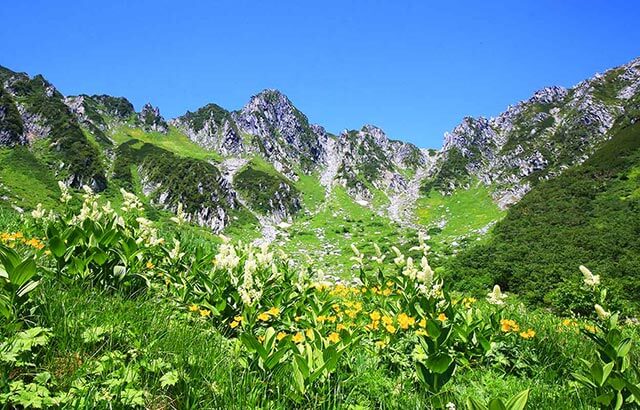
The Four Seasons in the Central Alps
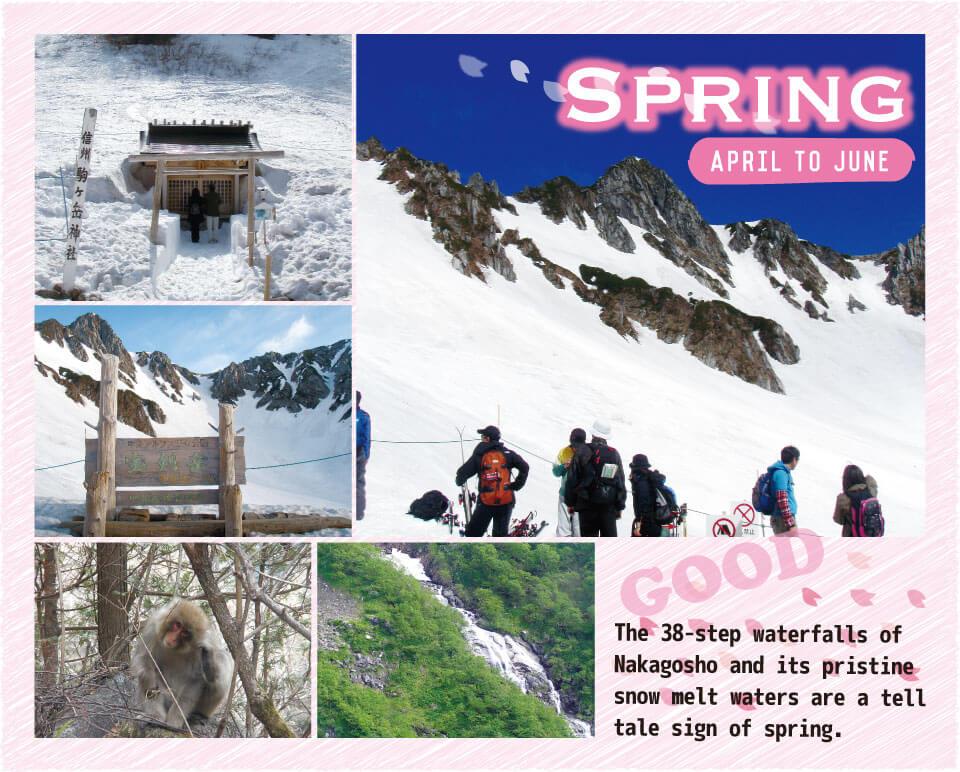

- The mountain cherry trees and new green vegetation from the bus window
- One of Japan’s longest continuous waterfalls with 38 steps (Nakagosho) fed by pristine snow melt waters
- Senjojiki Ski Area offers stunning views of mountain top snow until the end of May
Senjojiki Cirque in the spring still has dazzling snow left over while the base of the mountain is enjoying the cherry blossom season. The entire cirque appears like one huge, expansive ski slope. Atop this snowy valley enjoy dynamic skiing and snowboarding or just playing in the snow.


- The entire cirque becomes one treasure trove of alpine flora including dazzling wildflowers
- Find yourself shocked at the temperature difference between the scorching heat of the lower valley and cool average temperature of 11 degrees Celsius at the Senjojiki Cirque
Alpine summers are short but very refreshing. Mornings and nights envelope the peak and surroundings in a layer of cold air. The cirque becomes a field of alpine flora that includes Miyama Kuroyuri, Kobaikeso, Koiwakagami, Tsugazakura and Chinguruma, to name but a few.
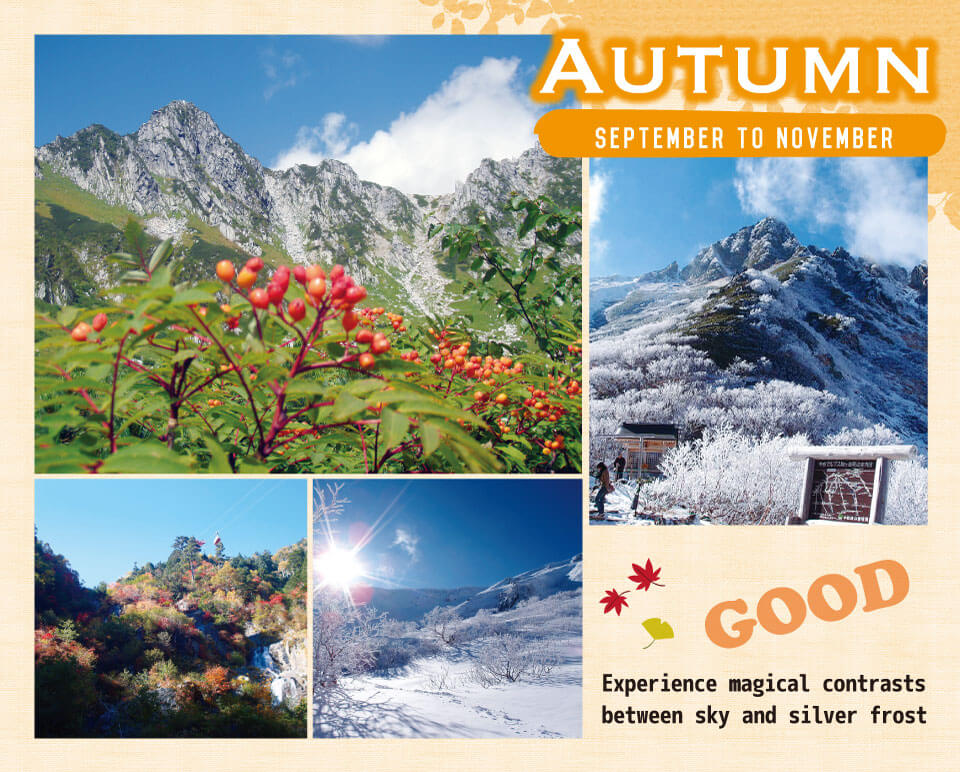

- Beginning of September: Be the first to see fall foliage with the alpine bearberry kicking things off
- Beginning of September to beginning of November: Three leveled fall foliage for prolonged peak viewing because of the elevation changes
- End of October to beginning of December: Witness crystal-like silver frost only one month out of the year
Beautiful fall colors descend from the mountain top to base with stunning beauty. The mountains are covered in vivid reds and yellows. At the same time, the fall colors and green pine trees together with white rocks provide a dazzling contrast.
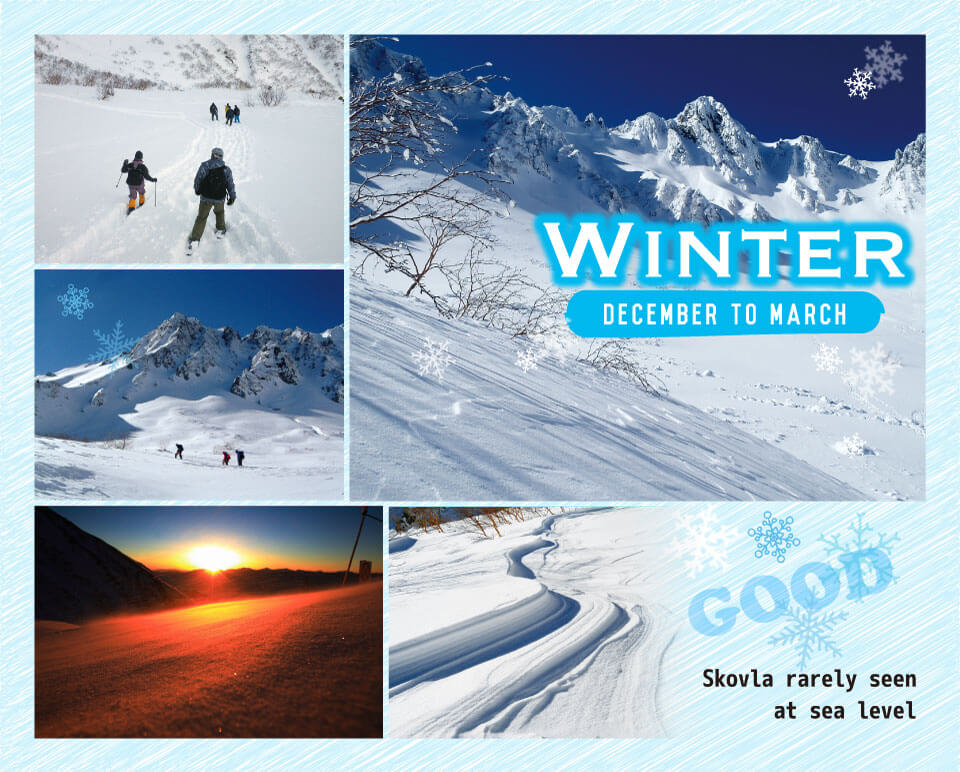

- Only Senjojiki allows anyone to explore alpine country during the heart of winter.
- Enjoy breathtaking views of the harsh cold outside from inside the warm hotel.
- Experience the skovla carved out by the winds and clicking sounds of the snow.
The pure white winter wonderland offers pristine beauty. Witness the dazzling sight of frozen trees reflecting the warm glow of sunrise. Also, watch as experienced mountain climbers and trekkers brave the harsh elements to ascend the surrounding winter peaks.
- + Spring
-


- The mountain cherry trees and new green vegetation from the bus window
- One of Japan’s longest continuous waterfalls with 38 steps (Nakagosho) fed by pristine snow melt waters
- Senjojiki Ski Area offers stunning views of mountain top snow until the end of May
Senjojiki Cirque in the spring still has dazzling snow left over while the base of the mountain is enjoying the cherry blossom season. The entire cirque appears like one huge, expansive ski slope. Atop this snowy valley enjoy dynamic skiing and snowboarding or just playing in the snow.
- + Summer
-


- The entire cirque becomes one treasure trove of alpine flora including dazzling wildflowers
- Find yourself shocked at the temperature difference between the scorching heat of the lower valley and cool average temperature of 11 degrees Celsius at the Senjojiki Cirque
Alpine summers are short but very refreshing. Mornings and nights envelope the peak and surroundings in a layer of cold air. The cirque becomes a field of alpine flora that includes Miyama Kuroyuri, Kobaikeso, Koiwakagami, Tsugazakura and Chinguruma, to name but a few.
- + Autumn
-


- Beginning of September: Be the first to see fall foliage with the alpine bearberry kicking things off
- Beginning of September to beginning of November: Three leveled fall foliage for prolonged peak viewing because of the elevation changes
- End of October to beginning of December: Witness crystal-like silver frost only one month out of the year
Beautiful fall colors descend from the mountain top to base with stunning beauty. The mountains are covered in vivid reds and yellows. At the same time, the fall colors and green pine trees together with white rocks provide a dazzling contrast.
- + Winter
-


- Only Senjojiki allows anyone to explore alpine country during the heart of winter.
- Enjoy breathtaking views of the harsh cold outside from inside the warm hotel.
- Experience the skovla carved out by the winds and clicking sounds of the snow.
The pure white winter wonderland offers pristine beauty. Witness the dazzling sight of frozen trees reflecting the warm glow of sunrise. Also, watch as experienced mountain climbers and trekkers brave the harsh elements to ascend the surrounding winter peaks.
Senjojiki's Average Temperature and What to Wear
Temperatures at Senjojiki Cirque vary greatly. At the height of summer high temperatures can reach 20 degrees Celsius, while in February in the middle of the harsh winter low temperatures can fall below negative 20 degrees Celsius. Be sure to dress for the elements accordingly using either thicker clothing than at sea level or layers of clothing.
- High temperature
- Low temperature
*Clothing when visiting for tourism
| Month | High | Average temperature | Average snowfall | Recommended clothing for walks around the cirque |
| Low | ||||
| January | -1℃ | -9.5℃ | 210cm | ●Down jacket ●Sweater ●Knit cap ●Gloves ●Thick socks ●Boots, etc. Cover every part of your body to stay warm |
| -20℃ | ||||
| February | -1℃ | -13℃ | 300cm | |
| -25℃ | ||||
| March | 6℃ | -7℃ | 390cm | |
| -20℃ | ||||
| April | 11℃ | -1.5℃ | 390cm | ●Long sleeves ●Wind breaker ●Shoes with grip that can get wet in the snow |
| -14℃ | ||||
| May | 12℃ | 3.5℃ | 280cm | |
| -5℃ | ||||
| June | 18℃ | 9.5℃ | 90cm | |
| -1℃ | ||||
| July | 21℃ | 13℃ | - | ●Long sleeve shirt ●Parka (for winter) ●Long pants ●Hat ●Sneakers (hiking boots or caravan shoes are recommended because of loose rocks) ●Rain gear |
| 5℃ | ||||
| August | 20℃ | 14℃ | - | |
| 8℃ | ||||
| September | 18℃ | 11℃ | - | |
| 4℃ | ||||
| October | 15℃ | 6℃ | - | |
| -3℃ | ||||
| November | 8℃ | -1℃ | 20cm | ●Down jacket ●Sweater ●Knit cap ●Gloves ●Thick socks |
| -10℃ | ||||
| December | -1℃ | -9℃ | 90cm | |
| -17℃ |
- + Average Temperature
-
- High temperature
- Low temperature
- + What to Wear
-
*Clothing when visiting for tourism
Month High Average temperature Average snowfall Recommended clothing for walks around the cirque Low January -1℃ -9.5℃ 210cm ●Down jacket
●Sweater
●Knit cap
●Gloves
●Thick socks
●Boots, etc.
Cover every part of your body to stay warm-20℃ February -1℃ -13℃ 300cm -25℃ March 6℃ -7℃ 390cm -20℃ April 11℃ -1.5℃ 390cm ●Long sleeves
●Wind breaker
●Shoes with grip that can get wet in the snow-14℃ May 12℃ 3.5℃ 280cm -5℃ June 18℃ 9.5℃ 90cm -1℃ July 21℃ 13℃ - ●Long sleeve shirt
●Parka (for winter)
●Long pants
●Hat
●Sneakers (hiking boots or caravan shoes are recommended because of loose rocks)
●Rain gear5℃ August 20℃ 14℃ - 8℃ September 18℃ 11℃ - 4℃ October 15℃ 6℃ - -3℃ November 8℃ -1℃ 20cm ●Down jacket
●Sweater
●Knit cap
●Gloves
●Thick socks-10℃ December -1℃ -9℃ 90cm -17℃
Senjojiki Cirque Hiking Trail

The Central Alps Senjojiki Cirque offers up close encounters with blooming alpine flora from summer to autumn. Kengaike Pond is the most popular place to photograph these wildflowers. You can also see the magnificent Southern Alps, including Mt. Hokendake and other jagged peaks. One loop takes about 40 to 50 minutes.
Mountain Climbing
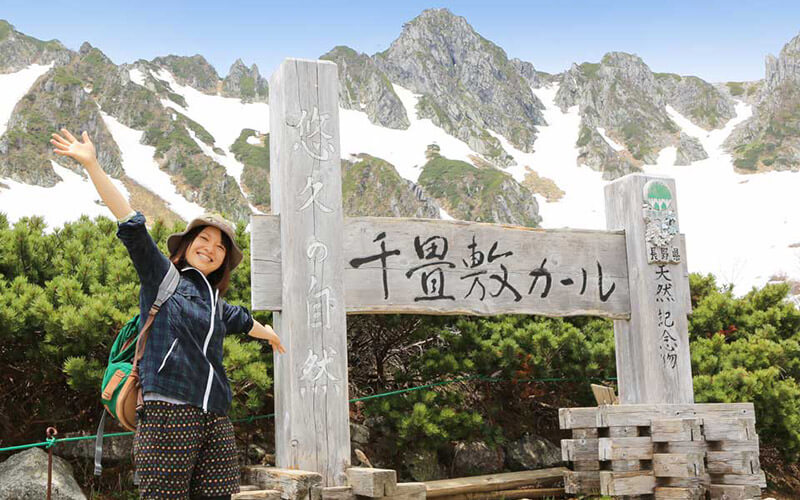
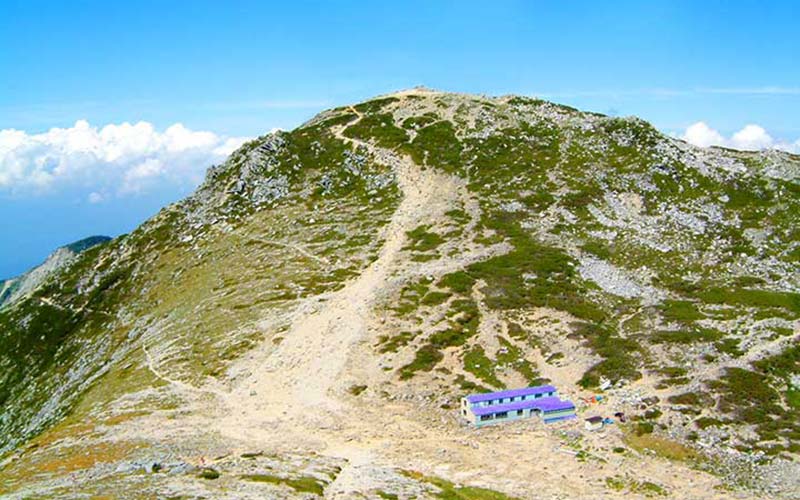
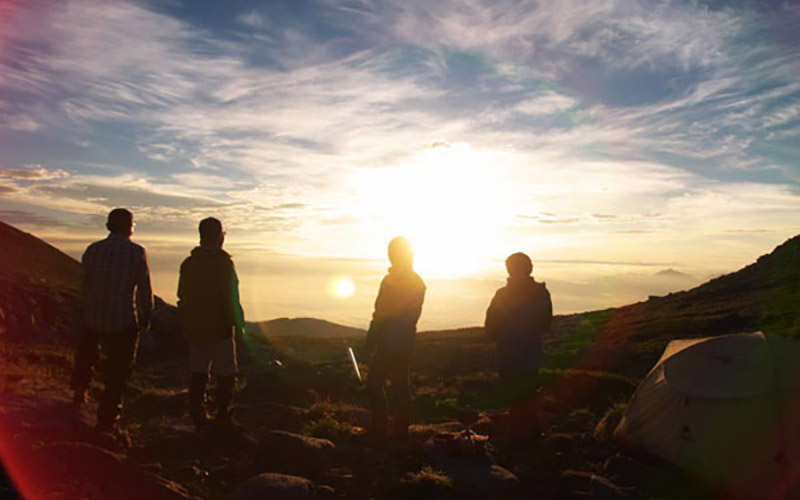
The Central Alps are now more easily accessible than ever thanks to the opening of the Komagatake Ropeway. This makes it possible for not only experienced mountain climbers but novice members of the general public to try their hand at mountain climbing.
The mountain climbing trail for the peak of the 2,956-meter-tall Mt. Kiso Komagatake, the highest peak in the Central Alps, is not overly physically demanding so it is recommended even for beginnings as a half-day hike.